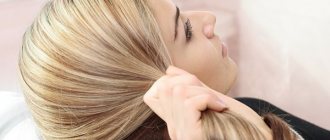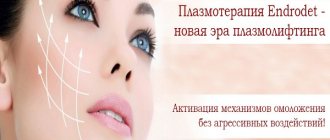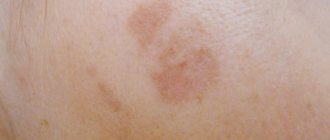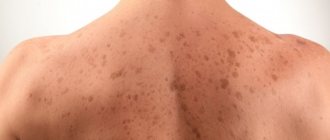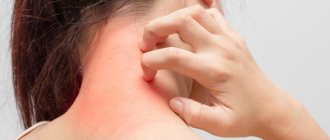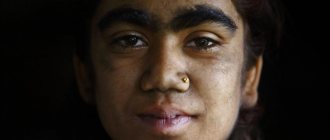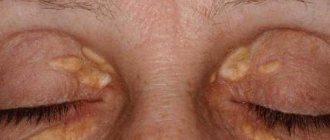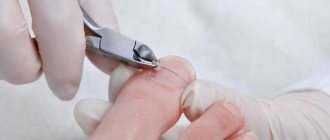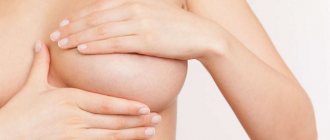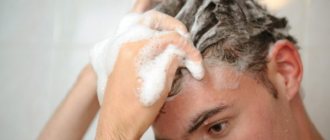Description of the disease
Experts note that scalp psoriasis is the most common type of disease (more than 60% of cases) . The patient may initially notice redness, peeling and rashes in the parting area of the scalp. As the disease progresses, inflammation is observed in the back of the head, behind the ears, and on the forehead.
Psoriasis is characterized by a violation of epidermal cell division, resulting in pathological growth. Plaques form, which subsequently become inflamed.
Scalp psoriasis is a chronic disease that anyone can experience.
The scalp is most susceptible to the development of psoriasis due to the special structure of the epithelium in this area. The situation is aggravated by regular trauma to the skin during combing or washing your hair. In the absence of quality treatment, the pathological process develops rapidly. In addition to the scalp, plaques begin to appear on the ears, palms, abdomen, knees, etc.
Lichen squamosus (another name for psoriasis) is a disease that can affect almost anyone. However, statistics show that young women aged 15–25 years suffer from pathology more often. The risk of encountering the disease is higher in people whose relatives have already had psoriasis once.
General therapy
When treating scalp psoriasis at home, restorative therapy plays an important role. Dermatologists say that it is not enough to choose an ointment for psoriasis on the head; it is necessary to take measures to strengthen the entire body as a whole.
Complex therapy includes:
- sedatives;
- antidepressants and tranquilizers;
- immunostimulants;
- vitamins;
- tonics;
- cytostatics;
- retinoids;
- antihistamines.
Since exacerbation of psoriasis is always accompanied by stress and disruption of the nervous system, an important role is played by sedatives and tranquilizers. The goal of such therapy is to minimize the destructive effects of stress, improve sleep, restore normal functioning of the nervous system and normalize mood. Sedative drugs include Glycine, Persen, alcohol tinctures of valerian, peony and motherwort. The listed medications are available without a prescription and are mild medications that will help normalize sleep and get rid of stress. For depression, neuroses and other mental disorders that appear against the background of psoriasis, you should consult a neurologist about prescribing potent medications such as tranquilizers and antidepressants.
Additionally, vitamins (A, C, E, group B) are prescribed. Their goal is to normalize the activity of the nervous system, have an antioxidant effect, accelerate skin regeneration and normalize the immune system. Quite often doctors prescribe Aevit. Preparations containing antioxidants help remove toxins from the body, restore skin regeneration and protect cells from negative influences.
Treatment cannot be done without vitamins
Immunostimulants must be used, but only as prescribed by a doctor. Self-administration of such drugs can negatively affect your well-being and aggravate the course of the disease.
Cytostatics and retinoids stop the excessive division of epidermal cells, acting from the inside. Due to the large number of contraindications and side effects, such medications are prescribed by a dermatologist after a comprehensive examination.
Classification
The disease can manifest itself in several forms. Depending on the severity of symptoms, there are:
- Mild psoriasis. Small single lesions appear on the head (occupying no more than 3% of the entire surface of the scalp);
- Medium psoriasis. Plaques cover up to 10% of the skin surface.
- Severe psoriasis. The disease affects the entire scalp. Large scales appear, after removal of which ulceration is observed.
Depending on the manifestations of the disease, the following types are distinguished:
- Pustular psoriasis. Red nodules (pustules) appear on the scalp, which eventually merge into large areas of inflammation.
- Non-pustular (vulgar) psoriasis. Extensive red spots (plaques) form on the scalp. Associated symptoms are severe itching and dryness of the inflamed area.
- Seborrheic psoriasis. Peeling of the scalp is observed against the background of increased oil content.
Causes and development factors
Today, experts cannot name the exact cause of the appearance of unpleasant symptoms on the scalp. However, it has been noted that certain factors contribute to the development of pathology. These include:
- Genetic predisposition. If one of the parents suffers from psoriasis, the child has a 50% chance of developing the pathology.
- Endocrine and metabolic disorders in the body. Changes in hormonal levels can lead to plaque formation on the scalp or other areas of the body.
- Papilloma virus. Psoriasis is a non-infectious disease. However, pathogenic microflora can provoke dysfunction of the skin. As a result, the epidermis will begin to grow and plaques will form.
- Stress and emotional stress. Psoriasis is often observed in people prone to neuroses and depression. Many women experience unpleasant symptoms after childbirth.
- Malfunctions of the immune system. The trigger can be a severe infectious disease or persistent chronic infections. Statistics indicate that psoriasis is three times more common in patients suffering from HIV.
Emotional stress can cause the development of psoriasis
It has been noticed that psoriasis initially develops in dry areas of the epidermis. In this regard, we can conclude that proper scalp care reduces the chances of encountering unpleasant symptoms.
Causes
Long-term practice of observing psoriasis does not allow doctors and scientists to say unequivocally what causes psoriasis. Most experts are inclined to believe that pathology most often affects people who have a genetic predisposition to it. However, the last decade has shown that everyone can face the disease, regardless of social status, age and gender.
It was only possible to identify factors that increase the body’s susceptibility to internal and external pathogens of the disease:
- stress and nervous tension;
- the presence of inflammatory processes in the body;
- disturbances in the gastrointestinal tract and sudden changes in hormonal levels;
- decline in immunity;
- taking potent medications;
- unfavorable environmental conditions;
- tendency to allergic reactions;
- prolonged exposure to low temperatures;
- alcohol abuse, smoking.
Symptoms of the pathological process
The disease develops in several stages:
- The first stage is progressive. The first signs of the pathological process begin to appear.
- The second stage is stationary. Old plaques do not progress, but new pathological elements begin to appear around them.
- The third stage is regressive. The plaques gradually disappear, and light spots appear in their place.
Initially, pink papules (rounded nodules raised above the skin) appear on the head. The problem is that with a mild form of the disease, the patient may not notice changes in the scalp and may not seek medical help for this reason. In the meantime, the disease will progress. Over time, unpleasant symptoms become more pronounced, the number of papules increases, and plaques form that peel and itch. It is at this stage that most patients seek advice from a dermatologist.
Severe itching of the scalp is one of the signs of the disease
As the skin is scratched, the plaques become inflamed, cracks and wounds appear. There is a risk of bacterial infection. In addition to itching, another unpleasant symptom develops - pain.
The formation of large whitish dandruff is a typical sign of scalp psoriasis . Over time, the scales become larger and resemble flakes. The skin in the area of inflammation thickens and becomes rough. The lack of proper treatment leads to inflammation spreading beyond the hairline. The plaques become noticeable to others, which leads to the development of serious psychological complexes in the patient.
Psoriasis of the scalp can also occur in children, but the symptoms are somewhat different. The inflammation is more reminiscent of diaper rash. Initially, the skin turns red, which is why weeping appears and scales form. Psoriasis in children is much more difficult to treat.
Treatment methods
It is impossible to say exactly how to treat psoriasis. An individual treatment regimen is selected for each person; it is drawn up taking into account the stage of the disease, age, gender and other characteristics of a particular organism. The only thing that unites the methods is their complexity.
It is impossible to achieve good results using only tablets or exclusively shampoos and lotions; you need to use all possible options to eliminate the symptoms and causes of the pathology. But during the period of remission you should not relax either.
Let's consider the most common methods that are used to combat pathology.
Hormone therapy
Glucocortisteroids (or hormonal drugs) are used to relieve severe symptoms of psoriasis (itching, flaking, redness, inflammation, swelling of the scalp). They can be used for no more than 5 days, since a long period of therapy leads to withdrawal syndrome, when after the end of treatment the disease returns with renewed vigor.
Also, in the area of application, the dermis may become discolored, become very thin and susceptible to secondary infections, which will be difficult to eliminate. However, unlike systemic steroid drugs (tablets, injections, IV solutions), which are used to suppress the disease in more advanced forms, creams, balms, gels and ointments do not have such a pronounced toxic effect on the body. They should not be used to treat too sensitive or large affected areas; the period of use is no more than 5 days.
The products have the following advantages:
- do not poison the body;
- are characterized by maximum efficiency with minimal exposure;
- easily distributed on the skin;
- are colorless and odorless;
- do not glue or dry out curls.
List of popular drugs:
- Lotion "Diprosalik" - contains salicylic acid and betamethasone dipropionate (corticosteroid), dissolves the stratum corneum of the skin, exfoliates scales, creating all the conditions for the penetration of the steroid into the deep layers of the dermis.
- Shampoo "Friderm Zinc" - the therapeutic effect is achieved due to the presence of activated zinc-pyrithione, it relieves inflammation, eliminates fungi and bacteria, and regulates the permeability of cell membranes.
- Gel "Xamiol" - contains steroids that relieve inflammation and swelling, suppress immune reactions, it also contains an analogue of vitamin D3 - calcium portiol, it has an inhibitory effect on the proliferation of keratinocytes and allows dermal cells to fully mature.
- Ointment of liquid consistency "Naftaderm" - contains 10% naphthalan oil, which increases blood circulation in the scalp, relieves inflammation and softens keratinized areas.
- Topic 10 cream suppresses the growth of keratoplasts and effectively moisturizes, as it contains urea and lactic acid.
Non-hormonal drugs
Medicines that do not contain corticosteroids can also provide a therapeutic effect. They are represented by ointments, shampoos and creams that have anti-inflammatory, vasoconstrictor, soothing and moisturizing properties.
They can be used at any stage of the disease to reduce the formation of plaques, exfoliate dead cells, and relieve itching.
The active components of the compositions are:
- zinc pyrithione;
- tar;
- salicylic acid;
- kertiol, etc.
Any zinc preparation can be used without restrictions, since it does not have a negative effect on the skin and body. But tar-based products should be treated with caution, since they greatly dry out the dermis - the optimal number of applications is 2 times a week.
Effective means:
- Shampoo "Friderm Tar". The main active ingredient is purified coal tar, which not only has a healing effect, but also cleanses the skin well from ointments and creams, it also constricts blood vessels and gives a drying effect.
- Node K shampoo from Bioderma. Contains ichthyol, zinc pyrithione, salicylic acid and juniper oil, soothes the dermis, relieves inflammation and itching.
- Shampoo "Skin-Cap". Fights inflammation and bacteria due to the content of zinc pyrithione, regulates the functioning of the sebaceous glands, moisturizes, restores the activity of enzymes and cell membranes.
- Squafane shampoo. Salicylic acid and juniper oil have a therapeutic effect; these components relieve the unpleasant sensation of itching and irritation, and effectively separate plaques and dead cells.
Systemic treatment
Sometimes it is not possible to get rid of psoriasis with local therapy. In this case, you have to resort to taking systemic medications. They have a wide range of side effects, so they should only be prescribed by a doctor.
The main task of the remedies is to eliminate the causes of the disease. They are used for severe forms of pathology. As soon as the situation normalizes, a transition to local medications is made.
Systemic medications include:
- "Methotrexate" - slows down metabolism and stops the uncontrolled division of dermal cells;
- "Cyclosporine" - suppresses local immunity;
- “Acitretin” – slows down the regeneration of dermal cells;
- Adalimumab is an injectable drug that affects the cells of the immune system.
Folk remedies
Home remedies made from available ingredients can also help fight psoriasis. They have antifungal, antibacterial, soothing and drying properties. The drugs are also effective in treating secondary infections, which often occur in advanced stages of the disease.
However, please note that you can use any ointments, lotions, decoctions and other homemade compositions only after consulting a doctor. They cannot be used as a complete treatment, but are only part of complex therapy.
Let's look at the most popular and effective recipes.
- Copper sulfate. We will need 50 g of burnt copper sulfate, previously ground into powder, and 50 g of yellow sulfur. Mix the ingredients, add 25 g of finely chopped celandine and the same amount of birch tar, then add 150 g of pork or goose fat. Mix the mixture well, place in a water bath and melt for 15 minutes, then remove from the stove and stir until the product has cooled. Apply the ointment to the affected areas, leave it overnight, and wash it off in the morning.
- Oil compress. Mix olive and peanut oil in equal proportions, heat in a water bath, apply to areas where there are plaques. Rub in with light massage movements. We cover our heads with a shower cap and go for a night's rest. In the morning, wash off the remaining composition with medicated shampoo or Listerine in the proportion of 60 g of solution per 0.5 liter of water.
- Onion compress. Grind the onion on a fine grater or using a blender, apply the pulp to damp hair, gently rubbing into the skin. We put on a plastic cap and an insulating cap, soak the mixture for 20 minutes, and wash off with medicated shampoo.
- Infusion of celandine. The product can cause a negative reaction if there are wounds and cracks in the dermis, so it is not suitable for use in very advanced stages of psoriasis. To prepare the medicine, take 60 g of dried celandine, add 0.5 liters of alcohol, leave for 12 hours in a dark, cool place. Lubricate the areas where there are plaques.
- Soda compress. Baking soda not only relieves painful symptoms of the disease, but also improves blood and lymph flow and removes free radicals from the body. To prepare the mixture, take a couple of tablespoons of baking soda and add warm water so that the product acquires a creamy consistency. Apply it to the affected areas, leave for a couple of hours, and wash off with water.
Diagnostics
A dermatologist is able to identify the disease thanks to the external signs and complaints of the patient. A number of symptoms (psoriatic triad) allow differentiation of the disease from other dermatological pathologies.
Table - psoriatic triad
| Blood dew phenomenon | With psoriasis, capillaries can grow into the upper layers of the skin. In this regard, even a slight mechanical impact can lead to the appearance of blood dew on the surface. |
| Stearic stain phenomenon | When the papules are scraped, scales appear, which are easily removed with shavings. |
| Terminal film phenomenon | Under the scales there is a red shiny surface. |
The doctor can detect pathology at the first examination
Scalp psoriasis must be differentiated from pityriasis rosea, seborrheic eczema, and papular form of syphilis. Additionally, histological examinations of the scalp can be performed. The development of psoriasis is indicated by the almost complete absence of the granular layer of the dermis and significant swelling of the spinous layer.
How to properly treat scalp psoriasis
An integrated approach, including drug therapy, physiotherapeutic procedures, and diet, helps to achieve a complete cure of the disease. For patients suffering from psoriasis, sanatorium-resort treatment is indicated. A healthy lifestyle, quality nutrition, and lack of stress play an important role.
Drug therapy for psoriasis includes the following groups of drugs:
- Sedatives. Valerian tincture shows good results. With its help, it is possible to relieve nervous excitability, thereby improving the condition of the epidermis.
- Antihistamines. Medicines such as Tavegil and Claritin relieve tissue swelling, which promotes their rapid recovery.
- Cytostatics. Drugs from this group inhibit pathological cell growth. For scalp psoriasis, Methotrexate may be prescribed.
- Corticosteroids. Drugs from this group are used for local therapy and only in cases of severe forms of the pathological process. Systemic hormonal drugs can worsen the disease.
- Aromatic retinoids. Vitamin A analogues accelerate the process of tissue regeneration and restore damaged skin. Acitretin is widely used in the treatment of psoriasis.
- Immunomodulators. The drugs Imudon and Timalin show good results.
Additionally, the patient is given vitamin therapy. In the most difficult cases, intravenous drip administration of Hemodez solution is indicated.
In most cases, treatment for scalp psoriasis can be done at home. In hospital treatment is carried out only in severe cases of the pathological process, and also when a bacterial infection is associated with the disease. In this case, antibiotics will necessarily be included in the complex therapy.
Drug treatment of psoriasis - photo gallery
Imudon stimulates the body's defenses
Antihistamine relieves swelling and itching
Methotrexate inhibits pathological cell growth
A sedative normalizes the patient’s emotional state
Features of nutrition for psoriasis
There are no serious dietary restrictions for psoriasis. You should avoid processed foods, alcohol, and spicy foods. The diet should contain foods rich in complete proteins and lipotropic substances. These are fermented milk products, fresh vegetables and fruits, and cereals. Compliance with a diet is the key to successful treatment of psoriasis. Under no circumstances should you overeat. Skipping main meals is also not recommended.
The diet should contain foods rich in vitamin A
The diet should be rich in vitamin A (a substance responsible for tissue regeneration). This vitamin is found in large quantities in fresh carrots, parsley, apricots, broccoli, liver, and fish oil.
It will be possible to restore the condition of the epidermis faster if you follow the drinking regime. An adult should drink at least 1.5 liters of clean water per day.
Physiotherapy
The following procedures show good results for scalp psoriasis:
- Paraffin applications. Thanks to the thermal effect, it is possible to relieve itching and improve blood circulation in inflamed areas.
- UV irradiation. The technique allows you to speed up the process of cell regeneration.
- Phototherapy. The procedure has a local immunomodulatory effect, which increases the chances of stable remission.
- Laser treatment. A series of flashes are generated on the scalp using a special attachment. The procedure is not painful. As a result, blood circulation improves and remission occurs.
All physiotherapeutic procedures are aimed at accelerating the regeneration processes of damaged tissue. The ultraviolet comb deserves special attention. This is a device that can be used for a number of dermatological pathologies. It can be used for scalp psoriasis. The advantage is that the ultraviolet comb can be used at home.
Ultraviolet comb is an effective treatment for scalp psoriasis
The operation of the device is based on mid-wave ultraviolet radiation aimed directly at the lesion. Experts note the high effectiveness of ultraviolet combs and the almost complete absence of side effects.
Cosmetical tools
Even the most effective shampoos will not help completely get rid of the unpleasant disease. But cosmetics can be used as part of symptomatic therapy. Special shampoos moisturize the scalp and relieve itching. The following remedies show good results:
- Friederm Tar;
- Aloe vera;
- Algopix;
- Shampoos with ketoconazole (Nizoral, Sebozol).
The possibility of using any of the listed cosmetics should be discussed with your doctor.
Folk remedies for psoriasis
With the help of traditional medicine recipes you can significantly improve the condition of your scalp. However, traditional treatment should not be neglected. Incorrect therapy can provoke rapid development of the disease.
Herbal collection
In order to prepare the medicine, you need to collect the following ingredients:
- black elderberry flowers;
- lingonberry leaf;
- celandine;
- elecampane root;
- St. John's wort;
- series.
The components should be used dry. Pour a tablespoon of herbal mixture into a glass of boiling water and simmer over low heat for 10 minutes. Then the mixture must be left under a closed lid for at least an hour and strained. The medicine should be taken half a glass twice a day after meals.
Honey mask
You need to prepare the following ingredients in advance:
- 2.5 tbsp. spoons of fresh honey;
- 1 chicken egg white;
- 1 teaspoon garlic juice;
- half a tube of baby cream;
All components must be thoroughly mixed using a blender. You should have the consistency of thick sour cream. The product must be applied to the affected areas of the head for 20 minutes daily, then carefully rinsed off without damaging the inflamed skin.
Soda
The product softens dry areas and has a soothing and anti-inflammatory effect. Lotions with soda show good results. The powder must be diluted with a small amount of water to obtain a mushy substance. The resulting mixture is applied to the affected areas and washed off after an hour.
A popular method of treating psoriasis is the internal intake of soda. It is believed that the product removes waste and toxins from the body. Such therapy may be hazardous to health. This is especially true for people suffering from gastrointestinal diseases.
Birch tar
The product effectively relieves inflammation and fights many dermatological diseases. Tar will be highly effective if used at the initial stage of psoriasis. The product is available for sale in almost any pharmacy. It is recommended to apply it to the affected areas with a cotton pad daily for 10 minutes, then rinse with warm water. You can use tar soap to wash your hair.
Folk remedies for psoriasis - photo gallery
Baking soda will soften crusts, relieve itching and inflammation
Birch tar is an excellent anti-inflammatory agent
Herbal tea will improve skin condition with long-term use
A honey mask will moisturize the scalp and relieve itching
Treatment of seborrheic psoriasis with folk remedies
To treat a child for seborrheic psoriasis, you need to consult a doctor and combine medications and folk remedies.
Ash from dry rosehip branches mixed with Vaseline helps a lot . This composition must be periodically smeared on the child’s head.
Recipes with celandine
¼ cup of dry celandine is poured with 0.5 liters of medical alcohol and infused for several hours, maybe 1 night. The tincture turns out to be strong, you need to smear it on your head. If you are intolerant, the product should be washed off the scalp and rinsed with chamomile infusion.
Light Vaseline is mixed with two whites of chicken eggs, a spoonful of linden honey and a spoonful of celandine herb, ground into powder, are added. This ointment should be applied to the affected areas of the skin once a day. Treatment - for 5 days with a break.
Celandine is rich in substances that have antioxidant, antiviral, anti-inflammatory, anti-allergenic, antimicrobial effects on the body, and is widely used as a folk remedy to get rid of not only psoriasis on the head, but also as a remedy for papillomas, warts, and lichen.
Related article:
All about psoriatic arthritis: symptoms, treatment, photos
Recipe with honey
Mix a spoonful of honey with egg white and a small amount of baby shampoo. Apply the product to the scalp as an ointment, leave for 15 minutes, rinse.
Recipes for exacerbation of seborrheic psoriasis
Dilute two teaspoons of baking soda with a glass of warm water at 45 degrees. Use as shampoo, rinse off the scalp after at least a minute.
Rub castor oil into the scalp affected by psoriasis once a week, leave on the head for an hour, preferably longer. Then wash off with tar soap or shampoo.
Recipe for psoriasis of the scalp
Apply grease ointment for psoriasis to the affected skin and leave overnight under a plastic cap or film. You can smear it on your head, leave it on for a day, rinse it off and smear it again. This product actively exfoliates dead cells from the surface of the skin and reduces the number of white flakes.
Wash your hair with tar shampoo or soap, leave it on your hair and scalp for 15 minutes, rinse, you can use regular shampoo at the end.
How to treat psoriasis with aloe
Concentrated Aloe Vera gel is applied to the affected scalp at least 3 times a day. Aloe treatment should be carried out for 1 month.
Mix aloe juice with water and consume 100 grams of the product per day. Honey is added to improve the taste. You should drink 50 grams of aloe water before breakfast and 50 grams before lunch.
Mix ½ cup of water with ½ cup of aloe juice. Mix well and apply this mixture to your scalp. Massage gently for 5 minutes. After 30-45 minutes, rinse with warm water and dry your hair thoroughly. Repeat this procedure regularly. To achieve quick treatment results, you can add 2 drops of tea tree essential oil to the product.
People with psoriasis need to change their diet, since at this time a violation of fat metabolism occurs. Eliminate junk food, limit spicy, fried, salted, smoked foods, you also need to give up seasonings and spices, and remove chocolate and citrus fruits from your diet.
What not to do with scalp psoriasis
Caring for hair and scalp with psoriasis should be delicate and careful. Washing should be done with smooth movements so as not to accidentally damage the plaque. During therapy you will have to give up cosmetics containing aggressive chemical components. These are hairsprays and dyes, styling gels.
Patients suffering from scalp psoriasis complain of excessive hair loss. To prevent the thickness of your hair from suffering, you should avoid using hard combs. The ideal option would be a brush with soft bristles. You will also have to give up any methods of curling your hair.
Treatment prognosis and prevention
Psoriasis is a disease that is chronic and requires long-term treatment. However, there is no serious threat to life. Compliance with hygiene rules, proper nutrition, quality sleep, lack of stress and regular walks in the fresh air - all these measures, together with drug therapy, will lead to an improvement in the condition of the scalp, and stable remission will occur.
Neglecting the doctor’s recommendations, on the contrary, will provoke the progression of the pathological process. Psoriasis can spread to the ears, causing itching and a burning sensation. Lack of quality therapy will lead to hearing impairment over time.
